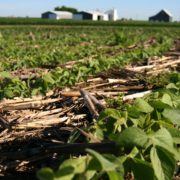Reduced Tillage Intensity Contributes to Higher Soil Carbon and Improved Crop Yield
A study from South Dakota State University concluded that reductions in tillage intensity have contributed to an increase in soil organic carbon levels and higher corn and soybean yields in South Dakota, Iowa, Minnesota, and Nebraska. The study credits the combined impact of improved genetics, reduced tillage intensity, and increased adoption of other conservation practices, along with greater soil water-holding capacity, with resulting increases in annual crop yields. The study considered more than 12 million soil samples taken over a 21-year period, and researchers determined that, as tillage intensity declined, approximately 1.24 billion metric tons of carbon were stored in the top six inches of surface soil. Soil science professor David Clay says that increased soil organic matter made higher yields possible, creating a feedback loop that continues to increase both soil organic matter and yields. In addition, researchers say that the soil with higher organic matter requires less nitrogen inputs and is more resilient to extreme weather events.
Related ATTRA publication: Reducing Tillage Intensity in Organic Production Systems

 USDA
USDA
 NCAT
NCAT